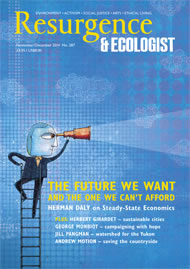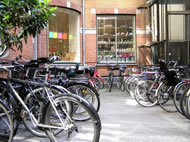I live in a village, but my recent work has been mostly focused on cities. A contradiction in terms? Well, not really. I am not an urban planner, but a cultural ecologist, and a great concern of mine is to deal with the impacts of cities on the world’s ecosystems, the atmosphere and the oceans. A recent very popular book by the American author Edward Glaeser was called Triumph of the City, subtitled How Our Greatest Invention Makes Us Richer, Smarter, Greener, Healthier and Happier, but in my view an urbanising world, in which most people become city dwellers in ever larger cities, could actually be an environmental and social tragedy in the making.
As economic and consumer hubs, cities are characterised by a huge throughput of resources. They are the economic powerhouses of a globalising world, and whilst they currently hold just over 50% of the world’s population, 80% of global GDP is produced in them. Apart from a near-monopoly on the use of fossil fuels, metals and concrete, an urbanising humanity now consumes nearly half of Nature’s annual ‘output’ as well. All this has enormous consequences for all life on Earth.
It has become fashionable to claim that urban living is much more resource-efficient than rural living – country dwellers have to use their cars more, they tend to live in detached houses that require more heating than urban terraced houses, and many drive to nearby market towns to shop in the same supermarkets as city people. Yes, country people tend to grow more vegetables and fruit, but by and large their consumption patterns have come to closely resemble those of city dwellers. In Europe, villages close to cities are increasingly taken over by commuters, and the countryside in between has become a drive-through agro-industrial landscape to which local villages are now barely connected.
All this is true for Europe as well as America and Australia, but what about China and India, which between them have a third of the world’s population? Here village people make much more frugal use of resources than urban dwellers. But as Chinese villagers become city dwellers, they typically increase their per capita resource consumption fourfold. In recent years, hundreds of millions of people across Asia have moved from humble village dwellings to second homes in high-rise megacity tower blocks.
Whereas previously, as village people, they relied on biomass for heating and cooking, composted organic waste as crop fertiliser, and lived in family units, the move to the city tends to turn them into consumers, requiring a daily dose of fossil fuels and many other non-renewable resources. Meanwhile in the depleted village communities back home, the remaining farmers are driven to adopt cultivation systems that depend on fossil fuels, fertilisers and pesticides.
UN statistics show that hundreds of millions of people in Asia have risen out of poverty in the process of becoming urban dwellers: hence the “Triumph of the City”. But the tragedy I have alluded to is particularly concerned with the aggregated environmental impacts of an urbanising humanity, and this is largely ignored by urban planners and decision makers. We need to face up to the systemic problem that modern cities take resources from Nature but give little back in return to help assure the wellbeing of ecosystems on which the long-term viability of cities ultimately depends.
As they currently function, cities are ‘entropy accelerators’ – they deplete and downgrade the resources they depend on in the process of using them. As fossil energy is used and raw materials are processed, their quality inevitably deteriorates. Cities are not just structures but also processes: they are vast interconnected systems designed for turning energy into ‘work’ or motion, flowing along their roads, rails, wires and pipes. The manufactured products that are used on a daily basis inevitably end up either dumped or burned, or recycled into lower-grade objects. Order, which is established and maintained in the form of cities, causes disorder elsewhere in Nature. This cannot continue.
The position of urbanists today is similar to that of astronomers before Galileo: cities are regarded as the centre of the universe, and the world’s ecosystems are seen as somehow revolving around them. And yet let us be clear: cities are only appendages of living systems. The Earth is a vast web of life of which urban life has to be a beneficial part, or no part at all.
We need to acknowledge that urban living currently requires vast inputs from natural systems, from farmland and forests, as well as from mining activities. Urban decision makers tend to ignore the fact that whilst cities are built on only 3–4% of the world’s land surface, their ecological footprints cover much of the productive land surface of the globe. Urban populations collectively use the bulk of the world’s resources and are also prime contributors to environmental damage, biodiversity loss, pollution and climate change.
The time has come to take stock of urban impacts and to assess how they can be dramatically reduced. Circular economy and cradle-to-cradle thinking have been making great strides in recent years. My own work on the metabolism of cities – turning linear processes into circular processes – is closely connected to these ideas. But we need to go further. If we really want an urban world, we’d better make sure that cities become environmentally benign organisms. For me that means trying to create not just liveable and sustainable cities, but regenerative cities.
There can be a long-term future for humanity only if we develop a proactive relationship between our cities and the world’s ecosystems – nurturing Nature’s dynamism and abundance whilst only drawing on its income. This is all about cities giving back to as well as taking from Nature – helping to regenerate the soils, forests and watercourses that they depend on, rather than just accepting that they are ‘sustained’ in a degraded condition.
Across the world, different cities invariably face different challenges. In Europe, North America and Australia, where urban growth is now very limited, the primary task is to undertake ‘ecological retrofits’ of urban systems. In rapidly urbanising countries in Asia, Africa and South America, urban development needs to be ‘smart from the start’: defined by high standards of resource efficiency, with renewable energy as a key component.
In my new book, Creating Regenerative Cities, I have case studies that illustrate the steps towards regenerative urban development that are being taken across the world.
Copenhagen, a city of over 3 million people, is a remarkable example of green innovation. In its post-war urban plan of 1947, Copenhagen set out to develop along five ‘green fingers’, centred on commuter rail lines, which extend from the city’s ‘palm’, its dense city centre. In between the fingers, green wedges were created to provide land for both agriculture and recreational purposes.
Then, in 1962, as car traffic swamped the city, a radical redesign of the heart (or the palm) of the city was initiated. Copenhagen’s city council decided to establish a car-free pedestrian zone in the maze of narrow streets and historic squares. Today it is the largest inner-city pedestrian street system in the world. It has acquired a Mediterranean-style ambience, where markets, cafés, restaurants and green spaces proliferate.
In Copenhagen, initiatives on liveability, sustainability and regenerative development come together in a very effective way, with remarkable environmental as well as economic and social benefits. High levels of building energy efficiency, renewable energy and combined heat and power have become standard, and so has circular waste management. Due to a comprehensive network of cycle lanes, Copenhagen has more cyclists than most other European cities, and its public transport system is second to none. Offshore and onshore wind farms are much in evidence. The green economy in the capital region has grown dramatically in recent years, generating thousands of new jobs. But Copenhagen has further ambitions: it is working to become the world’s first carbon-neutral capital city by 2025!
Other cities have implemented similarly impressive measures, and in my book I have also highlighted Adelaide for its tremendous achievements in moving towards regenerative development.
In the UK, smaller towns such as Totnes and Stroud are pioneering citizen-led green initiatives. Larger cities such as Bristol are also showing great promise. In 2015 Bristol is European Green Capital and, under the leadership of independent mayor George Ferguson, vigorous new initiatives are being taken to put Bristol on the fast track to regenerative urban development.
But what about villages? Until recently they were the primary habitat of humanity, and they are at the traditional heart of human culture. Many villages across the world have sustained themselves over thousands of years in a continuous give-and-take with their local countryside. Across the world, there are about 2 million villages, but many now face a precarious future. The magnetism of the modern city and the loss of rural employment due to the mechanisation of farming and other factors have taken their toll. In rapidly industrialising countries such as China, pollution from factories and power stations has poisoned irrigation water and soils, forcing even more farmers off the land. And then there is the simple fact that the bright lights of ‘Petropolis’, the fossil-fuel-powered city, can’t easily be countered by the candle lights or paraffin lamps available in remote villages.
Britain exemplifies the global trends towards urbanisation in a particularly vivid manner. With some 80% of people living in cities, only a tiny fraction of the population is still engaged in farming and other aspects of the rural economy. Urban–rural migrants may contribute to the emergence of pretty-looking old-world villages with fast internet connections, but the link to the soil has largely been lost.
In some developing, urbanising countries, governments have initiated measures aiming to counter rural–urban migration, and to improve living conditions in villages – through rural education and health programmes, improved water supplies and sanitation, road construction, electrification and investment in rural economies. But such policies also tend to introduce urban cultural norms into rural areas. The spread of satellite dishes and multi-channel TV to remote rural communities can increase the fascination of local people, especially the young, with urban living.
Whilst villages have drawn the short straw in the competition with cities, it is time to define new opportunities for making them a viable part of the future, particularly in developing countries. Many NGOs across the world are trying to ensure that, despite the pressures of urbanisation, villages retain their relevance as a human habitat.
Foremost among these is the Global Ecovillage Network (GEN). Since the 1970s, many attempts have been made to create new ecovillages in Europe, North America and Australia. GEN aids these efforts. It consists of not only intentional communities created by refugees from the stresses of urban life, but also existing villages in the global South that want to exchange experiences about how to upgrade traditional practices with new ideas on permaculture farming, efficient crop irrigation and renewable energy systems.
Mahatma Gandhi said: “The future of India lies in its villages.” While the sheer pace of urbanisation is running counter to the sentiment of Gandhi’s statement – in India and elsewhere – it is becoming clear that the revival of villages needs to be undertaken with a clear sense of purpose. Even as the world continues to urbanise, the village has a vital role to play as the quintessential human habitat.
The ‘environmental boomerangs’ of an urbanising world are increasingly in evidence. Inhabiting planet Earth in a manner that enhances rather than degrades its ecosystems has become a primary challenge for humanity. Let us trust that we recognise what is at stake, and that we are able and willing to deal with it.








